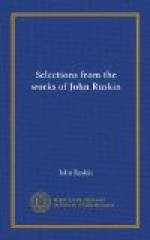[134] I.e., between November 17, 1796, and June 18, 1815.
[135] Joel iii, 13.
SELECTIONS FROM
THE STONES OF VENICE
The first volume of The Stones of Venice appeared in March, 1851; the first day of May of the same year we find the following entry in Ruskin’s diary: “About to enter on the true beginning of the second part of my Venetian work. May God help me to finish it—to His glory, and man’s good.” The main part of the volume was composed at Venice in the winter of 1851-52, though it did not appear until the end of July, 1853. His work on architecture, including The Seven Lamps, it will be noted, intervenes between the composition of the second and third volumes of Modern Painters; and Ruskin himself always looked upon the work as an interlude, almost as an interruption. But he also came to believe that this digression had really led back to the heart of the truth for all art. Its main theme, as in The Seven Lamps of Architecture, is its illustration of the principle that architecture expresses certain states in the moral temper of the people by and for whom it is produced. It may surprise us to-day to know that when Ruskin wrote of the glories of Venetian architecture, the common “professional opinion was that St. Mark’s and the Ducal Palace were as ugly and repulsive as they were contrary to rule and order.” In a private letter Gibbon writes of the Square of St. Mark’s as “a large square decorated with the worst architecture I ever saw.” The architects of his own time regarded Ruskin’s opinions as dictated by wild caprice, and almost evincing an unbalanced mind. Probably the core of all this architectural work is to be found in his chapter “On the Nature of Gothic,” in the main reproduced in this volume. And we find here again a point of fundamental significance—that his artistic analysis led him inevitably on to social inquiries. He proved to himself that the main virtue of Gothic lay in the unrestricted play of the individual imagination; that the best results were produced when every artist was a workman and every workman an artist. Twenty years after the publication of this book, he wrote in a private letter that his main purpose “was to show the dependence of (architectural) beauty on the happiness and fancy of the workman, and to show also that no architect could claim the title to authority of Magister unless he himself wrought at the head of his men, captain of manual skill, as the best knight is captain of armies.” He himself called the chapter “precisely and accurately the most important in the whole book.” Mr. Frederic Harrison says that in it is “the creed, if it be not the origin, of a new industrial school of thought.”
THE THRONE
VOLUME II, CHAPTER I




